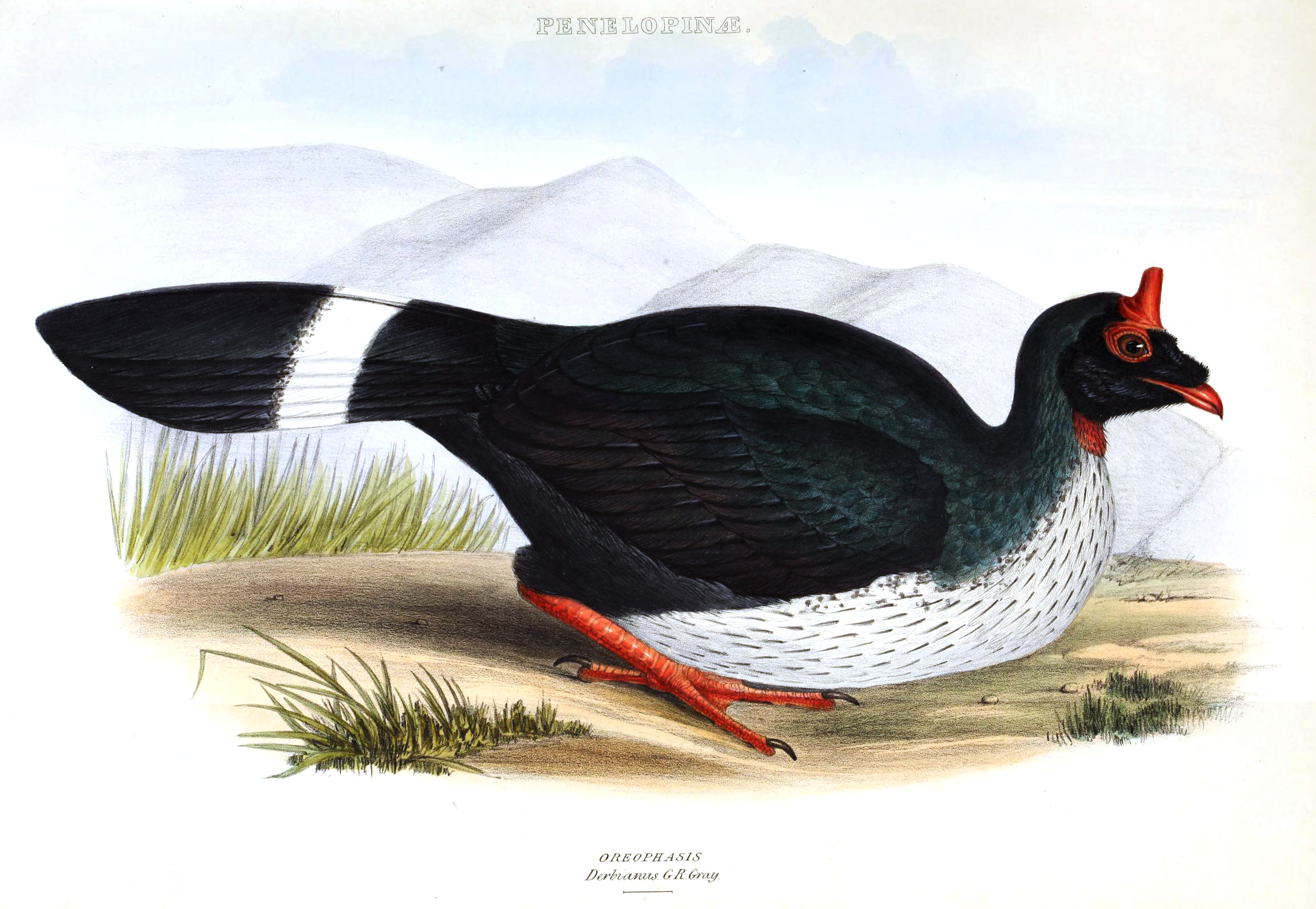Oreophasis Derbianus on:
[Wikipedia]
[Google]
[Amazon]
The horned guan (''Oreophasis derbianus'') is a large, turkey-like bird native to Central America. It is the only species in the genus ''Oreophasis''.
Gen. Bds., 3, 1844, p.(485).
is held in the collections of National Museums Liverpool at World Museum, with accession number D210. The specimen was collected from Volcán de Fuego, Guatemala by Don Joaquin Quinones circa 1843 and came to the Liverpool national collection via the

* ttp://aventurasnaturales.tripod.com/sitebuildercontent/sitebuilderpictures/.pond/oreophasis_derbianus.jpg.w560h373.jpg Horned Guan photobr>Article
Aventuras Naturales
Horned Guan image
(Oil paintings)
(for Mexico, three types)
Horned Guan photo gallery
VIREO
Horned Guan videos
on the Internet Bird Collection {{Taxonbar, from1=Q147327, from2=Q1089307 horned guan Birds of Guatemala Birds of Mexico horned guan horned guan Central American montane forests
Taxonomy
The holotype specimen of "''Oreophasis Derbianus'' " G.R. GrayGen. Bds., 3, 1844, p.(485).
is held in the collections of National Museums Liverpool at World Museum, with accession number D210. The specimen was collected from Volcán de Fuego, Guatemala by Don Joaquin Quinones circa 1843 and came to the Liverpool national collection via the
13th Earl of Derby
Edward Smith-Stanley, 13th Earl of Derby (21 April 1775 – 30 June 1851), KG, of Knowsley Hall in Lancashire (styled Lord Stanley from 1776 to 1832, known as Baron Stanley of Bickerstaffe from 1832-4), was a politician, peer, landowner, bui ...
’s collection which was bequeathed to the people of Liverpool.Phylogeny
The horned guan is not a true guan, but merely resembles these birds most in overall shape and color, whereas the horn is more reminiscent of the helmeted curassows. In fact, this species is the only survivor of a very ancient lineage ofcracid
The chachalacas, guans and curassows are birds in the family Cracidae. These are species of tropical and subtropical Central and South America. The range of one species, the plain chachalaca, just reaches southernmost parts of Texas in the Unit ...
s that has been evolving independently from all other living members of this family for at least 20 million years, and possibly as much as 40 million years.
Although it does not have any really close relatives among living cracids, the true guans are apparently most ''distant''. Given that the basal
Basal or basilar is a term meaning ''base'', ''bottom'', or ''minimum''.
Science
* Basal (anatomy), an anatomical term of location for features associated with the base of an organism or structure
* Basal (medicine), a minimal level that is nec ...
relationships of the living cracids are not well resolved, the horned guan is often placed into a distinct subfamily
In biological classification, a subfamily (Latin: ', plural ') is an auxiliary (intermediate) taxonomic rank, next below family but more inclusive than genus. Standard nomenclature rules end subfamily botanical names with "-oideae", and zoologi ...
, the Oreophasinae. Alternatively, it might be included in a large Cracinae with curassow
Curassows are one of the three major groups of cracid birds. They comprise the largest-bodied species of the cracid family. Three of the four genera are restricted to tropical South America; a single species of ''Crax'' ranges north to Mexico. ...
s and chachalacas.Pereira et al. 2002Description
It is approximately long, with glossy black dorsal plumage, red legs, a white iris, a yellow bill, and a red horn on top of its head. The breast and upper belly are white, and its long tail feathers are black with a white band near the base. Both sexes are similar. The young are duller with a smaller horn, and have a brown tail and wings.Distribution and habitat
The horned guan is distributed in humid mountain forests of southeastern Mexico (Chiapas
Chiapas (; Tzotzil language, Tzotzil and Tzeltal language, Tzeltal: ''Chyapas'' ), officially the Free and Sovereign State of Chiapas ( es, Estado Libre y Soberano de Chiapas), is one of the states that make up the Political divisions of Mexico, ...
) and Guatemala
Guatemala ( ; ), officially the Republic of Guatemala ( es, República de Guatemala, links=no), is a country in Central America. It is bordered to the north and west by Mexico; to the northeast by Belize and the Caribbean; to the east by H ...
in Central America. It is found at altitudes up to . Diet
Its diet consists mainly of fruits, green leaves, and invertebrates.Breeding
The female usually lays one or two eggs.
Conservation
Due to ongoing habitat loss, small population size, limited range, and hunting in some areas, the horned guan is evaluated as Endangered on the IUCN Red List of Threatened Species. It is listed on Appendix I of CITES.References
*Pereira, Sérgio Luiz; Baker, Allan J.& Wajntal, Anita (2002): Combined nuclear and mitochondrial DNA sequences resolve generic relationships within the Cracidae (Galliformes, Aves). ''Systematic Biology'' 51(6): 946–958. PDF fulltextExternal links
* ttp://aventurasnaturales.tripod.com/sitebuildercontent/sitebuilderpictures/.pond/oreophasis_derbianus.jpg.w560h373.jpg Horned Guan photobr>Article
Aventuras Naturales
Horned Guan image
(Oil paintings)
(for Mexico, three types)
Horned Guan photo gallery
VIREO
Horned Guan videos
on the Internet Bird Collection {{Taxonbar, from1=Q147327, from2=Q1089307 horned guan Birds of Guatemala Birds of Mexico horned guan horned guan Central American montane forests